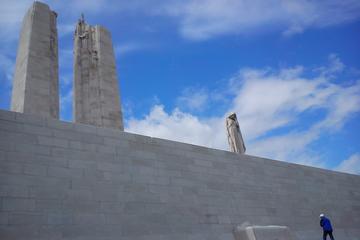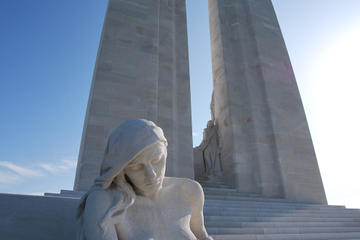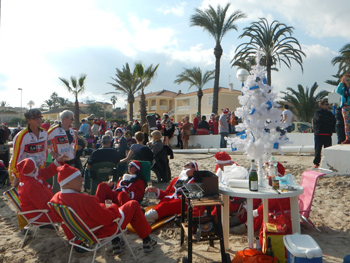
Torrevieja, Spain
by Darlene Foster
Christmas in Spain is a month long party consisting of numerous fiestas, parades, fireworks, brass bands, markets and food, lots of food. The first weekend in December is the official start of the Christmas season and it doesn’t take us long to get into the festive spirit. In our part of the Costa Blanca, it starts with a number of events celebrating Torrevieja´s Patronal Fiesta, dedicated to the patron saint of the city.
We start the celebrations by meeting a friend at The Casino for a drink and tapas on Saturday evening. The Casino is not a place to gamble but rather a social club to meet friends, attend concerts and listen to lectures. It is elegant, comfortable and tastefully decorated for Christmas. It is also central to many of the events.
 Our appetite satisfied, we line the streets with the throng to watch a parade of marching bands and representatives from local organizations carrying flowers to the Inmaculada Church in the main town square for the traditional Floral Offering. Caught up in the excitement, we follow the parade to the square.
Our appetite satisfied, we line the streets with the throng to watch a parade of marching bands and representatives from local organizations carrying flowers to the Inmaculada Church in the main town square for the traditional Floral Offering. Caught up in the excitement, we follow the parade to the square.
Once at the church, each group is announced and their floral offerings placed in a metal frame erected around the door of the church in which stands the patron saint. Most of the flowers are white and blue, the official colours of the town, with a few pinks and purples sprinkled in between. A Christmas market is held in the square to add to the spirit. There are so many people about it seems the entire town has turned out. It is both exciting and moving.
We return the following day to view the beautiful flowers in the daylight, just as Sunday Mass is over. I am thrilled to see some of the Spanish people wearing traditional clothes as they come out of the church.
 A large Christmas Belen, a Bethlehem Nativity scene, is set up in the main square. This amazing display depicts scenes from the life of Jesus including day to day life, local businesses and of course a wonderful nativity. The details are incredible, from a little girl on a swing to hens in the yard. The Belen is up until January 7 for everyone to enjoy at no cost. Every time I walk around the display I notice something new.
A large Christmas Belen, a Bethlehem Nativity scene, is set up in the main square. This amazing display depicts scenes from the life of Jesus including day to day life, local businesses and of course a wonderful nativity. The details are incredible, from a little girl on a swing to hens in the yard. The Belen is up until January 7 for everyone to enjoy at no cost. Every time I walk around the display I notice something new.
The Fiesta continues all Sunday with music, fireworks and entertainers. We stroll along the seafront and breathe in the inviting smells of the paella competition. Over 150 communities and groups take part in making their best paella. The Mayor and his entourage carry out the judging. They might be very full after sampling 150 paellas!
 Just as we are about to call it a day, we stumble upon a parade of unique paper mache giants and big heads outside the Casino. Delighted adults and children of all ages follow along. Monday is a holiday, Dia de la Inmaculada Concepcion, beginning with an early morning parade and ending with a solemn evening procession with the statue of the Inmaculada Concepion. The procession stops at the Casino for a fireworks display before returning back to the church. A perfect ending to a fabulous weekend of festivities to start the Christmas season.
Just as we are about to call it a day, we stumble upon a parade of unique paper mache giants and big heads outside the Casino. Delighted adults and children of all ages follow along. Monday is a holiday, Dia de la Inmaculada Concepcion, beginning with an early morning parade and ending with a solemn evening procession with the statue of the Inmaculada Concepion. The procession stops at the Casino for a fireworks display before returning back to the church. A perfect ending to a fabulous weekend of festivities to start the Christmas season.
On Christmas Day everyone goes to the beach, including us. The beach is packed with families enjoying barbeques and picnics. Most of the men, women, children and even the dogs, are dressed in red and sporting holiday hats. We make our way through the crowd, past a group of Santas relaxing on beach chairs and enjoying a beer in the sun. Another Santa, with Mrs. Claus on his arm, strolls along the beach. A brass band entertains with familiar Christmas songs. Everyone smiles and shouts Merry Christmas or Felize Navidad! We are invited to share a table with some friendly folks. The lack of snow doesn´t make me feel any less Christmasy.
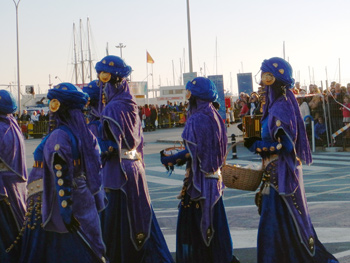 In Spain, the most important date in the Christmas season is not December 25. It is January 6, Epiphany, the day Three Kings from the east brought gifts to the infant Jesus. Fiesta de Los Tres Reyes Magos (Three Kings Day) starts on January 5 when the Three Wise Men arrive and parade through the streets handing out candies to all the children eagerly waiting. The parade ends at a church where the kings become part of a human nativity scene. That night the children put out their shoes and in the morning, if they have been good all year, they find them filled with gifts from the Magi. They leave out treats for the kings and water for the camels. Like children in North America do for Santa Claus and his reindeer.
In Spain, the most important date in the Christmas season is not December 25. It is January 6, Epiphany, the day Three Kings from the east brought gifts to the infant Jesus. Fiesta de Los Tres Reyes Magos (Three Kings Day) starts on January 5 when the Three Wise Men arrive and parade through the streets handing out candies to all the children eagerly waiting. The parade ends at a church where the kings become part of a human nativity scene. That night the children put out their shoes and in the morning, if they have been good all year, they find them filled with gifts from the Magi. They leave out treats for the kings and water for the camels. Like children in North America do for Santa Claus and his reindeer.
We have the pleasure of experiencing this event. We wait patiently as The Kings; Gaspar, representing frankincense, Melchior, representing gold, and Balthazar, representing myrrh, arrive by boat in the coastal town of Torrevieja. They greet us in Spanish and English, waving as they pass by to join the parade.
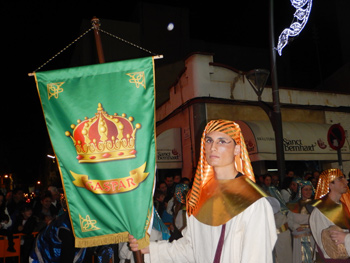 Along with their entourage, the kings participate in the traditional Epiphany parade that winds its way through the town. It is quite a spectacle with a variety of participants including Mary, Joseph, baby Jesus, Roman centurions, Egyptians, dancers, decorated riders, royal pages and a menagerie of animals. Excited children line the streets holding out bags for the many candies they receive from the participants in the parade, including the Three Kings. We enjoy the pageantry and spirit of the evening. Some of the children share their sweets with us.
Along with their entourage, the kings participate in the traditional Epiphany parade that winds its way through the town. It is quite a spectacle with a variety of participants including Mary, Joseph, baby Jesus, Roman centurions, Egyptians, dancers, decorated riders, royal pages and a menagerie of animals. Excited children line the streets holding out bags for the many candies they receive from the participants in the parade, including the Three Kings. We enjoy the pageantry and spirit of the evening. Some of the children share their sweets with us.
There are parties and family dinners on January 6th. We attend a King´s Day party around the pool and are treated to traditional King´s Day cake called Roscón. A sweet, large donut-shaped bread covered in glazed cherries and sugar hides a plastic toy buried inside. The person who finds the toy is guaranteed good luck for the next year. We don´t find a toy but enjoy the cake and the company. Another wonderful Spanish tradition discovered!
The Spanish people know how to celebrate. Everything is centred on family, community and religion. It is the true meaning of Christmas.
If You Go:
The Costa Blanca is the 200 kilometres of coastline in the province of Alicante, Spain between Valencia and La Manga. Torrevieja is located 24 miles or 38.62 kilometres south of Alicante airport and 20 miles or 32 kilometres North of Murcia airport. It is a great place to visit during the Christmas season.
About the author:
Darlene Foster is a dedicated writer and traveller. She is the author of a series of books featuring Amanda, a spunky young girl who loves to travel to interesting places such as the United Arab Emirates, Spain, England and Alberta, where she always has an adventure. Darlene divides her time between the west coast of Canada and the Costa Blanca of Spain. Visit www.darlenefoster.ca.
All photos are by Darlene Foster.


 Before the meal can start, the Christopsomo, or ‘Christ-bread’ must be broken and offered round. There is a small ceremony, where the eldest member of the gathering places a towel on the head, with the bread on it, and a young child breaks it in half. It is put straight into a basket and offered round. This is the signal that two things can begin: the meal and the dancing. Greek folk dancing can be very energetic, and I was glad that I was prepared. As a visitor, I did not know all the steps, but the local people were happy to see me join in and very welcoming. Nobody minded the odd mis-step.
Before the meal can start, the Christopsomo, or ‘Christ-bread’ must be broken and offered round. There is a small ceremony, where the eldest member of the gathering places a towel on the head, with the bread on it, and a young child breaks it in half. It is put straight into a basket and offered round. This is the signal that two things can begin: the meal and the dancing. Greek folk dancing can be very energetic, and I was glad that I was prepared. As a visitor, I did not know all the steps, but the local people were happy to see me join in and very welcoming. Nobody minded the odd mis-step. Santa Claus in Greece is known as Ai Vasilis,or St Basil, and he comes at the New Year. In Alexandroupolis, his coming is heralded on New Year’s Eve by a wonderful street pantomime involving two people dressed as a camel, complete with hump, and a third person who wears a strange sheepskin suit that tapers to an almost triangular point above the head. This is the camel driver, and he chases the camel around, mock threatening it with a stick, to great hilarity from the spectators. While this is going on, a group of people dressed in traditional costumes and with traditional instruments put on a display of folk dancing. The camel and companion go around the dancers, sometimes directly in their path, but somehow it all works out and no one falls over. Some years, Ai Vasilis will put in an appearance and march through the town, followed by the camel and driver as he leads them away at the end.
Santa Claus in Greece is known as Ai Vasilis,or St Basil, and he comes at the New Year. In Alexandroupolis, his coming is heralded on New Year’s Eve by a wonderful street pantomime involving two people dressed as a camel, complete with hump, and a third person who wears a strange sheepskin suit that tapers to an almost triangular point above the head. This is the camel driver, and he chases the camel around, mock threatening it with a stick, to great hilarity from the spectators. While this is going on, a group of people dressed in traditional costumes and with traditional instruments put on a display of folk dancing. The camel and companion go around the dancers, sometimes directly in their path, but somehow it all works out and no one falls over. Some years, Ai Vasilis will put in an appearance and march through the town, followed by the camel and driver as he leads them away at the end.
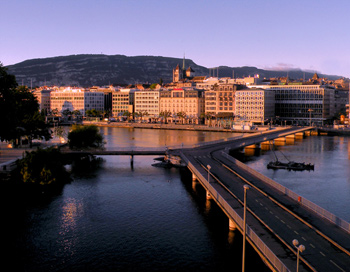
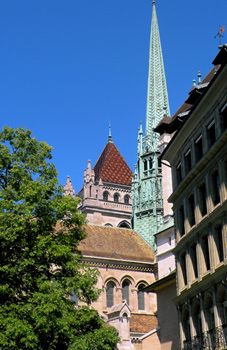 It became a key Protestant city-state during the Reformation in the mid-1500s, when French theologian John Calvin was the dominant figure. Geneva offered safe haven to Protestants persecuted in Catholic countries. French Huguenots, including prosperous professionals and craftsmen, poured in. Ursula points out medieval buildings with arched Gothic windows on the lower floors, but a simpler and contrasting style above. To make room for all the newcomers, Ursula tells us, extra stories were hastily added to many houses, hence the quirky architecture.
It became a key Protestant city-state during the Reformation in the mid-1500s, when French theologian John Calvin was the dominant figure. Geneva offered safe haven to Protestants persecuted in Catholic countries. French Huguenots, including prosperous professionals and craftsmen, poured in. Ursula points out medieval buildings with arched Gothic windows on the lower floors, but a simpler and contrasting style above. To make room for all the newcomers, Ursula tells us, extra stories were hastily added to many houses, hence the quirky architecture.
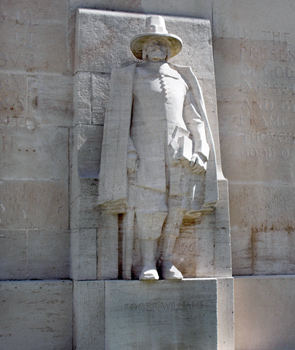 We come to a park on the grounds of the university fringed by a long, high rampart of stone. Formerly a section of the medieval city wall, this is now known as the Reformation Wall. Inaugurated in 1909 to commemorate the 400th anniversary of Calvin’s birth, it is the backdrop to ten giant statues of key Europeans from Reformation times, including Calvin himself. There is also the Scottish Presbyterian, John Knox, who sought refuge in Geneva when Mary Tudor (“Bloody Mary”) ascended the English throne and restored Roman Catholicism in Britain. Some of the figures, including Oliver Cromwell and Roger Williams, never set foot in Geneva itself. Born and raised in England, Williams studied theology, became a Puritan, and rejected the Church of England. He sailed to Boston a decade after the first Pilgrims arrived in Salem and shortly after the Massachussetts Bay colony was founded.
We come to a park on the grounds of the university fringed by a long, high rampart of stone. Formerly a section of the medieval city wall, this is now known as the Reformation Wall. Inaugurated in 1909 to commemorate the 400th anniversary of Calvin’s birth, it is the backdrop to ten giant statues of key Europeans from Reformation times, including Calvin himself. There is also the Scottish Presbyterian, John Knox, who sought refuge in Geneva when Mary Tudor (“Bloody Mary”) ascended the English throne and restored Roman Catholicism in Britain. Some of the figures, including Oliver Cromwell and Roger Williams, never set foot in Geneva itself. Born and raised in England, Williams studied theology, became a Puritan, and rejected the Church of England. He sailed to Boston a decade after the first Pilgrims arrived in Salem and shortly after the Massachussetts Bay colony was founded. Ursula tells us how his ideas eventually had impact in the Old World as well, especially influencing the constitution of Geneva. During the era of Calvin, the city was entirely Protestant. No Catholic churches were allowed. But by 1847, times had changed. Geneva’s leading statesman, James Fazy, was drafting a new constitution. Years earlier, in Paris, Fazy had been friendly with the French General Lafayette, who had fought the British alongside George Washington and admired the American political system. Fazy incorporated many principles derived from the U.S. Constitution. Church and state were separated, and religious freedom guaranteed. Catholicism was again tolerated in Geneva. Protestantism lost its exclusive status.
Ursula tells us how his ideas eventually had impact in the Old World as well, especially influencing the constitution of Geneva. During the era of Calvin, the city was entirely Protestant. No Catholic churches were allowed. But by 1847, times had changed. Geneva’s leading statesman, James Fazy, was drafting a new constitution. Years earlier, in Paris, Fazy had been friendly with the French General Lafayette, who had fought the British alongside George Washington and admired the American political system. Fazy incorporated many principles derived from the U.S. Constitution. Church and state were separated, and religious freedom guaranteed. Catholicism was again tolerated in Geneva. Protestantism lost its exclusive status.


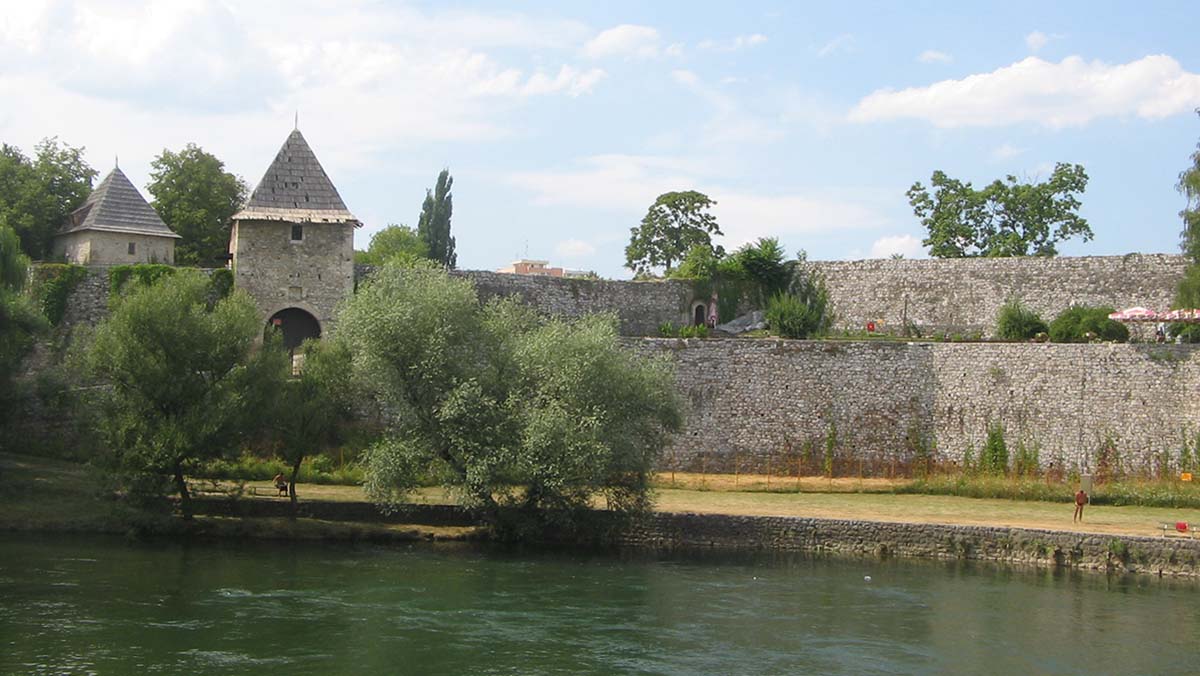
 The town doesn’t have any notable architectural structure. The buildings are mostly in a style of socrelism, which are legacy of the communist architectonic style. There are some old buildings and homes in the centre of city from Austro-Hungarian (19th century) time or even earlier from Ottoman Empire period. The rest of the city looks like a small village with modest homes, often with huge gardens with vegetables, fruits and animals.
The town doesn’t have any notable architectural structure. The buildings are mostly in a style of socrelism, which are legacy of the communist architectonic style. There are some old buildings and homes in the centre of city from Austro-Hungarian (19th century) time or even earlier from Ottoman Empire period. The rest of the city looks like a small village with modest homes, often with huge gardens with vegetables, fruits and animals.
 The food is a mix of Turkish with Serbian traditional food. The most popular meal is pork or lamb called cevapi. I had chance to visit all the ex-Yugoslavia countries and found that Bosnia is the cheapest. An order of five huge portions of cevapi and one medium portion of cevapi, lots of drinks (beers, coffees, waters, juices…) and the whole bill was less than 25€. Visit the restaurant Mujo’s. This restaurant has a long tradition since 1924 and the famous and traditional recipe of Banya Luka’s cevap began from this place. The owners suggest taking yogurt with cevaps, Order a salad and try kaymak (a type of salty cream cheese). After this huge portion of meat you will pass the dessert, but leave space for one Turkish coffee at the end. If you are vegetarian you may have a problem to find something to eat. Even at the bakery the products are mostly with meat, but you can find some nice pies with cheese. They have also very famous pie with meat called burek.
The food is a mix of Turkish with Serbian traditional food. The most popular meal is pork or lamb called cevapi. I had chance to visit all the ex-Yugoslavia countries and found that Bosnia is the cheapest. An order of five huge portions of cevapi and one medium portion of cevapi, lots of drinks (beers, coffees, waters, juices…) and the whole bill was less than 25€. Visit the restaurant Mujo’s. This restaurant has a long tradition since 1924 and the famous and traditional recipe of Banya Luka’s cevap began from this place. The owners suggest taking yogurt with cevaps, Order a salad and try kaymak (a type of salty cream cheese). After this huge portion of meat you will pass the dessert, but leave space for one Turkish coffee at the end. If you are vegetarian you may have a problem to find something to eat. Even at the bakery the products are mostly with meat, but you can find some nice pies with cheese. They have also very famous pie with meat called burek. In the Bosnian region of the Republica Srpska, the food is very healthy. You can find organic food here because it is a culture of growing fruits and vegetables. Almost every family has some space out of town or on the edge of city for a garden.
In the Bosnian region of the Republica Srpska, the food is very healthy. You can find organic food here because it is a culture of growing fruits and vegetables. Almost every family has some space out of town or on the edge of city for a garden.


 The landscape here is flat, and has been farmed – and fought over – for centuries. Tilled land spreads in all directions, dotted by the occasional stone farmhouse, a church spire, a copse of trees. Shrapnel from the war still surfaces each season as the fields are farmed. The heavy soil stuck to my shoes, and all too easily turns to mud. A confusion of back roads loop and intersect through small villages, where horse-drawn carts are still in use.
The landscape here is flat, and has been farmed – and fought over – for centuries. Tilled land spreads in all directions, dotted by the occasional stone farmhouse, a church spire, a copse of trees. Shrapnel from the war still surfaces each season as the fields are farmed. The heavy soil stuck to my shoes, and all too easily turns to mud. A confusion of back roads loop and intersect through small villages, where horse-drawn carts are still in use. Beneath the Hôtel de Ville is an entrance to the Boves, or medieval tunnels. The origin of the name is uncertain; however, from the 10th century limestone was quarried here, until the practice was moved outside the city amidst fears the town would collapse. The tunnels run along five different levels, at times up to twenty meters deep. Most of the buildings on Le Place des Héros have their own entrance, now used mainly as cellars or for storage (and an exquisite restaurant, La Faisanderie, perfect after a day touring the battlefields).
Beneath the Hôtel de Ville is an entrance to the Boves, or medieval tunnels. The origin of the name is uncertain; however, from the 10th century limestone was quarried here, until the practice was moved outside the city amidst fears the town would collapse. The tunnels run along five different levels, at times up to twenty meters deep. Most of the buildings on Le Place des Héros have their own entrance, now used mainly as cellars or for storage (and an exquisite restaurant, La Faisanderie, perfect after a day touring the battlefields).
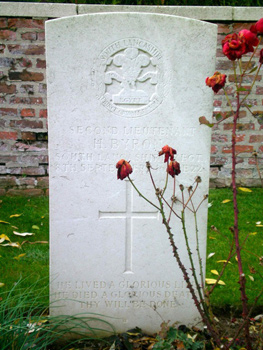 The Canadian National Vimy Memorial encompasses a 250 acre battlefield park, which includes the area of the Battle of Vimy Ridge (9th April, 1917). Both Allied and German trenches have been preserved, and it is still possible to walk along them. The trenches never ran in a straight line, and had alcoves at regular intervals for shelter from bombs and snipers. Some barbed-wire stakes remain; earlier ones with only one hole, and a later design which could hold three stands of barbed wire. These also had the advantage of having a screw on the base, allowing them to be silently screwed into the heavy soil, and not hammered.
The Canadian National Vimy Memorial encompasses a 250 acre battlefield park, which includes the area of the Battle of Vimy Ridge (9th April, 1917). Both Allied and German trenches have been preserved, and it is still possible to walk along them. The trenches never ran in a straight line, and had alcoves at regular intervals for shelter from bombs and snipers. Some barbed-wire stakes remain; earlier ones with only one hole, and a later design which could hold three stands of barbed wire. These also had the advantage of having a screw on the base, allowing them to be silently screwed into the heavy soil, and not hammered.